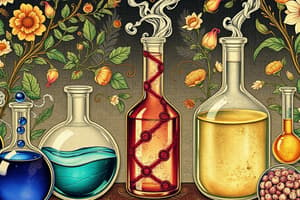Podcast
Questions and Answers
Which of the following is an example of a homogeneous mixture?
Which of the following is an example of a homogeneous mixture?
- Salt and sulphur
- Sodium chloride and iron filings
- Salt dissolved in water (correct)
- Oil and water
Heterogeneous mixtures have uniform composition throughout.
Heterogeneous mixtures have uniform composition throughout.
False (B)
What is a mixture?
What is a mixture?
A substance consisting of two or more pure components that are physically combined.
Mixtures are constituted by more than ______ kind of pure form of matter.
Mixtures are constituted by more than ______ kind of pure form of matter.
Match the type of mixture with its description:
Match the type of mixture with its description:
Which of the following is a characteristic of homogeneous mixtures?
Which of the following is a characteristic of homogeneous mixtures?
The intensity of color in a homogeneous mixture is always the same, regardless of the amounts of components.
The intensity of color in a homogeneous mixture is always the same, regardless of the amounts of components.
Give two examples of heterogeneous mixtures.
Give two examples of heterogeneous mixtures.
What causes the Tyndall effect?
What causes the Tyndall effect?
Particles in a suspension are not visible to the naked eye.
Particles in a suspension are not visible to the naked eye.
What two components make up a colloidal solution?
What two components make up a colloidal solution?
What is a suspension?
What is a suspension?
The scattering of a beam of light is called the ______ effect.
The scattering of a beam of light is called the ______ effect.
Colloidal particles can be separated by filtration.
Colloidal particles can be separated by filtration.
Match the following:
Match the following:
Which of the following is an example of the Tyndall effect in nature?
Which of the following is an example of the Tyndall effect in nature?
Which gas is produced by Group I when dilute sulphuric acid or dilute hydrochloric acid is added?
Which gas is produced by Group I when dilute sulphuric acid or dilute hydrochloric acid is added?
The composition of a compound can vary throughout the sample.
The composition of a compound can vary throughout the sample.
What term describes a mixture where the components are not uniformly distributed?
What term describes a mixture where the components are not uniformly distributed?
The major component of a solution is called the _______.
The major component of a solution is called the _______.
Match the following terms with their descriptions:
Match the following terms with their descriptions:
Which of the following characteristics describes hydrogen sulphide gas?
Which of the following characteristics describes hydrogen sulphide gas?
The properties of a mixture are different from those of its constituents.
The properties of a mixture are different from those of its constituents.
What type of separation techniques are used for mixtures to be separated into pure substances?
What type of separation techniques are used for mixtures to be separated into pure substances?
What is the primary purpose of the chromatography process described?
What is the primary purpose of the chromatography process described?
Dyes in black ink are soluble in water, which allows them to rise on filter paper.
Dyes in black ink are soluble in water, which allows them to rise on filter paper.
What does the thermometer measure during the distillation process?
What does the thermometer measure during the distillation process?
The colored component that is more soluble in _______ rises faster during chromatography.
The colored component that is more soluble in _______ rises faster during chromatography.
At what stage does the thermometer reading become constant during heating?
At what stage does the thermometer reading become constant during heating?
Fractional distillation is used to separate components of a mixture with similar boiling points.
Fractional distillation is used to separate components of a mixture with similar boiling points.
What is the method called that is used for separating miscible liquids based on their boiling points?
What is the method called that is used for separating miscible liquids based on their boiling points?
Match the following processes with their descriptions:
Match the following processes with their descriptions:
Which of the following is NOT a property of metals?
Which of the following is NOT a property of metals?
Mercury is a metal that is solid at room temperature.
Mercury is a metal that is solid at room temperature.
What are the two groups of materials formed in the given activity with iron filings and sulphur?
What are the two groups of materials formed in the given activity with iron filings and sulphur?
Non-metals are usually __________ conductors of heat and electricity.
Non-metals are usually __________ conductors of heat and electricity.
Match the following elements with their classification:
Match the following elements with their classification:
Which property is NOT characteristic of non-metals?
Which property is NOT characteristic of non-metals?
Which metal is liquid at room temperature?
Which metal is liquid at room temperature?
Iron filings and sulphur can form a __________ when combined and heated.
Iron filings and sulphur can form a __________ when combined and heated.
What is the solubility of potassium nitrate at 313 K?
What is the solubility of potassium nitrate at 313 K?
Sodium chloride has a variable solubility at different temperatures.
Sodium chloride has a variable solubility at different temperatures.
What would Pragya observe as the potassium chloride solution cools from 353 K?
What would Pragya observe as the potassium chloride solution cools from 353 K?
The solubility of ammonium chloride at 293 K is ______ grams.
The solubility of ammonium chloride at 293 K is ______ grams.
Match the following substances with their classification as a pure substance or mixture:
Match the following substances with their classification as a pure substance or mixture:
Which of the following substances has the highest solubility at 293 K?
Which of the following substances has the highest solubility at 293 K?
A saturated solution can contain more solute than it can dissolve at a given temperature.
A saturated solution can contain more solute than it can dissolve at a given temperature.
What happens to the solubility of most salts as temperature increases?
What happens to the solubility of most salts as temperature increases?
Flashcards
Mixture
Mixture
A combination of two or more pure substances.
Homogeneous Mixture
Homogeneous Mixture
A mixture with a uniform composition throughout.
Heterogeneous Mixture
Heterogeneous Mixture
A mixture with physically distinct parts and variable composition.
Solution
Solution
Signup and view all the flashcards
Suspension
Suspension
Signup and view all the flashcards
Colloidal Solution
Colloidal Solution
Signup and view all the flashcards
Variable Composition
Variable Composition
Signup and view all the flashcards
Physical Separation
Physical Separation
Signup and view all the flashcards
Tyndall Effect
Tyndall Effect
Signup and view all the flashcards
Dispersed Phase
Dispersed Phase
Signup and view all the flashcards
Dispersion Medium
Dispersion Medium
Signup and view all the flashcards
Centrifugation
Centrifugation
Signup and view all the flashcards
Filtration
Filtration
Signup and view all the flashcards
Chromatography
Chromatography
Signup and view all the flashcards
Solvent
Solvent
Signup and view all the flashcards
Dye
Dye
Signup and view all the flashcards
Filter Paper
Filter Paper
Signup and view all the flashcards
Distillation
Distillation
Signup and view all the flashcards
Boiling Point
Boiling Point
Signup and view all the flashcards
Fractional Distillation
Fractional Distillation
Signup and view all the flashcards
Solubility
Solubility
Signup and view all the flashcards
Compound
Compound
Signup and view all the flashcards
Hydrogen
Hydrogen
Signup and view all the flashcards
Hydrogen Sulphide
Hydrogen Sulphide
Signup and view all the flashcards
Mixture Properties
Mixture Properties
Signup and view all the flashcards
Homogeneous Solution
Homogeneous Solution
Signup and view all the flashcards
Concentration
Concentration
Signup and view all the flashcards
Separation Techniques
Separation Techniques
Signup and view all the flashcards
Metals
Metals
Signup and view all the flashcards
Non-metals
Non-metals
Signup and view all the flashcards
Properties of Metals
Properties of Metals
Signup and view all the flashcards
Metalloids
Metalloids
Signup and view all the flashcards
Examples of Metals
Examples of Metals
Signup and view all the flashcards
Examples of Non-metals
Examples of Non-metals
Signup and view all the flashcards
Mercury
Mercury
Signup and view all the flashcards
Saturated Solution
Saturated Solution
Signup and view all the flashcards
Temperature and Solubility
Temperature and Solubility
Signup and view all the flashcards
Potassium Nitrate at 313 K
Potassium Nitrate at 313 K
Signup and view all the flashcards
Potassium Chloride Observation
Potassium Chloride Observation
Signup and view all the flashcards
Hydrochloric Acid
Hydrochloric Acid
Signup and view all the flashcards
Colloid
Colloid
Signup and view all the flashcards
Homogeneous vs Heterogeneous Mixtures
Homogeneous vs Heterogeneous Mixtures
Signup and view all the flashcards
Study Notes
Chapter 2: Is Matter Around Us Pure?
- Matter around us is mostly mixtures of pure substances
- Pure substances have the same chemical nature throughout
- Mixtures contain more than one pure substance
- Mixtures can be classified into homogeneous (uniform composition) and heterogeneous (non-uniform composition)
Types of Mixtures
- Homogeneous mixtures (solutions):
- Uniform composition throughout
- Examples: Salt dissolved in water, sugar dissolved in water, soda water, air
- Heterogeneous mixtures
- Non-uniform composition
- Examples: Sand and salt mixture, iron filings and sulphur powder, oil and water mixture
What is a Solution?
- Homogeneous mixture of two or more substances
- One substance (solute) dissolves in another (solvent)
- Usually, the solvent is present in a larger amount.
- Components are uniformly distributed
- Examples: Sugar dissolved in water, salt dissolved in water, air, soda water
Concentration of a Solution
- Amount of solute in a given amount of solution
- Expressed as mass by mass percentage, mass by volume percentage, or volume by volume percentage
What is a Suspension?
- Heterogeneous mixture
- A solid does not dissolve, but remains as small particles suspended in a liquid
- Large particles are visible to the naked eye
- Particles settle down upon standing
- Examples: Sand and water, chalk powder and water, muddy water
What is a Colloidal Solution?
- Heterogeneous mixture
- Particles are too small to be seen by the naked eye, but are large enough to scatter light
- Examples: Milk, fog, mist, paint
Separating Mixtures
-
Different methods are used to separate mixtures depending on the types of components and their properties:
-
Evaporation: Separates solids dissolved in liquids by heating the liquid to evaporate the liquid leaving the solid behind.
-
Centrifugation: Separates mixtures based on the density differences between the components with high-speed rotation
-
Filtration: Separates solids from liquids by passing the mixture through a filter, trapping solid materials
-
Distillation: Separates miscible liquids by heating the mixture to vaporize the liquid with a lower boiling point, condensing the vapor, and collecting the pure liquid.
-
Chromatography: Separates components based on their different solubilities in a specific solvent
Physical Changes
-
Changes in the physical state of matter without altering its chemical composition.
-
Examples: melting ice, freezing water, boiling water, dissolving sugar in water
Chemical Changes
- Changes in the chemical composition of matter resulting in new substances.
- Examples: rusting of iron, burning of a candle, digestion of food
Studying That Suits You
Use AI to generate personalized quizzes and flashcards to suit your learning preferences.




